#hint: it’s related to the editor drawing i posted recently
Text
i just made something that i think is going to make people excited. all i need to do now is take some pictures and/or record something :)c
#blank’s post#hint: it’s related to the editor drawing i posted recently#i just need to pick a good song if i record smthn
0 notes
Text
Is Chapter 139 of Attack on Titan being messed up deliberately?
*Views are my own. I barely post anything on social media but I feel the need to express my thoughts as a long-term AOT fan.
You need to be a genius in getting everything wrong. As a reader who has been following the series for 8 years, the frustration and disappointment the recent chapters brought me are beyond words. The series Attack on Titan has long been known for its well written plotline, with pieces of hints eventually leading to the reveal of mysteries, ranging from the identity of enemies to the origin of titan. Isayama the author is more than capable in building a story, as evidenced by the carefully arranged setups and successful characterization in 130+ chapters. Probably echoed by other readers, the story surprisingly went downhill since Chapter 124 (aka the alliance arc) when pacing becomes slow with no major progress in overall plot. Eren who is the supposedly main protagonist is nowhere to be found in most of the chapters, let alone his inner thought. The conclusion in Chapter 139 is even more confusing, showing clear disconnection with previous chapters and major characters being OOC. There are fans who are kind enough to summarize the inconsistencies.

Chinese netizens’ comment on the story quality
I would interpret the bad writing in Chapter 139 as intentional, with two possible reasons, or both:
1). To betray and hurt the readers as expressed in his interview. He is free!
2). To passively protest against a plot change by his editorial team
“I was a big fan of Game of Thrones, so I can relate to the feelings of those fans who were disappointed with how the series ended. But when I’m drawing, I’m expressing my own feelings, and I think as long as I’m doing that, my fans will be able to accept whatever ending I come up with for them”. The question is – was Isayama hinting at a GOT-like ending that expressed his true feeling? Looking at his response at this point of time, was he foreshadowing a disappointment?
Personally I am a believer of (2) – the plot was hijacked. I see the pacing issue starting from Chapter 124 as Isayama and the editorial team trying to buy time in reconstructing the plot. This is the period when multiple minor subplots (e.g. Connie’s mom, Aruani, conflicts with Yeagerists like Daz, formation of Alliance, Reiner’s mom & Annie’s dad) are introduced and closed off shortly after, while Eren is nowhere to be found.
Also note that Isayama did not even show up in the interview/live stream after the end of the manga in on Apr 10 and Apr 14, 2021. The editor represented him instead. It was also revealed in the most recent live stream that the editorial team had quite a lot of influence over the plot, in which they changed the last few pages of Chapter 139.
As many of you have already raised, early chapters already mentioned the “only way to put a final end to the cycle of revenge” is to do a full rumbling. I believe this is the first draft of the ending of the story as this idea has been expressed more than once directly out of the mouth of Eren.

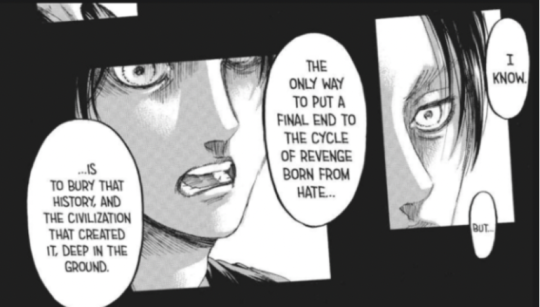
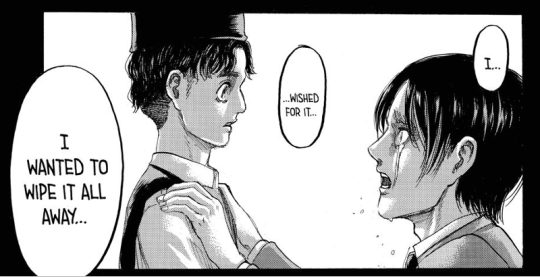
The other possible change is the way of how Ymir is being freed. In earlier chapter, Eren clearly understands what Ymir has been waiting for 2000 years in Chapter 122, and this is also the reason why Eren is able to start the rumbling in the first place. The possibility of Mikasa freeing Ymir is not being introduced until Chapter 138 (or 139), and certainly comes out of nowhere as the only people outside of path who have seen Ymir are Armin and Ramzi.

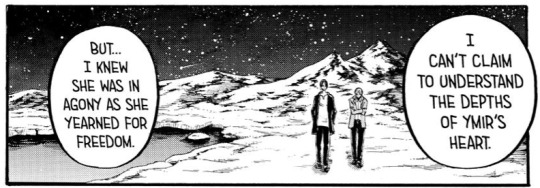
How is Chapter 139 being intentionally messed up?
The inconsistencies above suggest that at least two plot twists are only being decided at the very late stage of the story.
• Eren’s true intention (Eren Requiem vs. full rumbling) and the reasons behind
• What Ymir wants
Throughout Chapter 139, there are definitely better choice of words which even average Reddit/Twitter/Tumblr users were able to re-write in the past few days. However Isayama just somehow chose the worst way in presenting the story as if it is a shoutout to readers. The presentation also makes Chapter 139 memorable, though not in a way most have expected.
“Why Mikasa?” “Well…only Ymir knows that one…”
When I reread Chapter 139, it seems to me that Isayama is not trying to shy away from admitting the plot change. The disbelief from Armin’s way of saying “Huh? Did you just say Mikasa?” is an analogy to the readers’ reaction due to the lack of interaction between Ymir and Mikasa before the last panel of Chapter 138. Eren is also drawn with a resigned expression. If this is an over interpretation of the frame, Eren’s next response “Well…only Ymir knows that one…” directly points out how the statement lacks a clear and sound reasoning. You can translate it into “Well…only [the company/my editor] knows that one…” or “Nothing I just want to throw this in”. Isayama clearly knows what he is writing and indeed “only Ymir knows that one” becomes a meme.
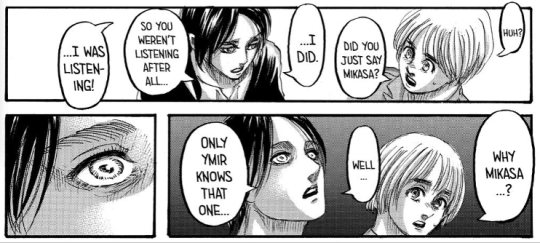
Also to add that prior to Chapter 139, Ymir has always been a parallel of Historia/Krista, not Mikasa, even as early as Chapter 51, but this plot was just somehow nowhere to be found eventually.
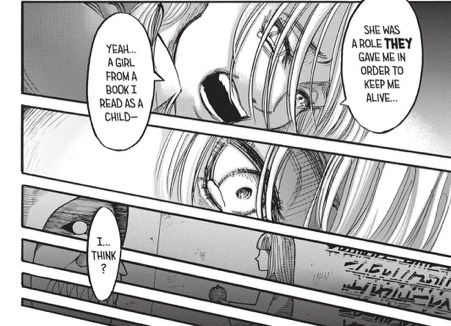

Why Rumbling?
The most disastrous consequence of a plot change, from wiping all history and civilization (that has been repeated in his conversation with Historia in Chapter 130 and his internal monologue in Chapter 131) to an Eren Requiem, is that it takes away all the justification and rationale for Eren to eliminate 80% of the population in the first place. Whether or not Eren executes the rumbling and dies willingly, the world will still be in conflict and future generation will remain in the forest. If the plan is to free Ymir, a better way is probably just asking Mikasa to chop his head off. That saves humanity (Ymir likes drama, after all!).
Isayama could have easily used phrases like “I just want to move forward” but he put “I don’t know why, but…I wanted to do that…I had to”. This is also Isayama speaking from the Eren – he does not know why Eren is doing rumbling just to achieve the 80% plan. He just “had to” draw it.

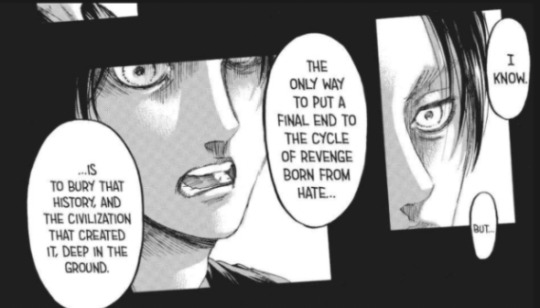
“10 Years, At least!”
This is probably the most debatable and dramatic part of the chapter. Eren expresses his love to Mikasa but the scene is presented in a way as if it is a kid throwing a tantrum. In addition to that there is Armin’s comment “Oh ok…I didn’t expect something that pathetic..” as if it is again, the readers’ comment. The scene is portrayed in an unbelievably comedic way, especially when you compare it with Eren’s conversation with Ramzi in Chapter 131, which is supposed to serve the same purpose in showing Eren’s human/soft side. Most importantly, freedom has always been Eren’s core value throughout the series. The outright contradiction this line shows only makes the whole idea of this panel questionable.
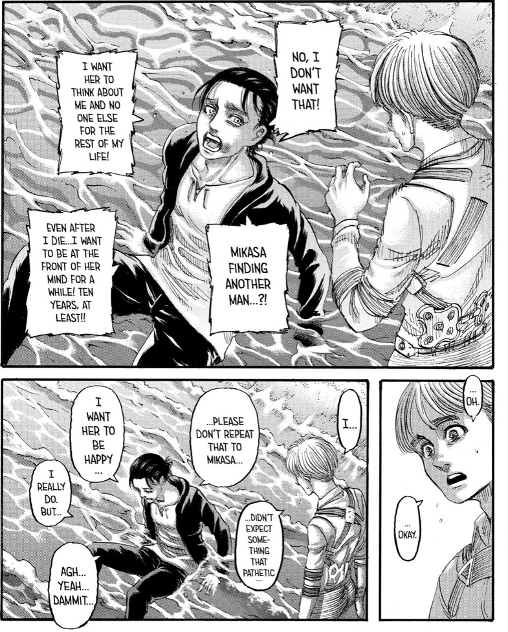

Character Regression
Needless to say, characters’ behaviours surprisingly regress back to the first arc, wiping out all developments throughout the series. The worst thing is it even kills the hype of re-reading the manga as you know the characters never grow, after all the sufferings and hearts sacrificed. Examples include:
• Eren is still a crybaby
• Mikasa remains trapped by her relationship with Eren and the scarf
• Historia is not living proudly for herself after the Uprising arc
• Reiner sniffs Historia’s letter after going through depression and wars (there is even a petition online asking Isayama to change this! You see how problematic this is.)
• Jean and the horse joke

Almost everything that could possibly go wrong is wrong in 1 chapter
These are written by the man who have been writing good chapters in the past 10 years. Can you believe it is just a lack of sense?
• “Thank you. You became a mass murderer for our sake.”
• The “poop” that Armin gives Eren (Isayama likes using meme right? :P)
• Eren’s face when he is punched
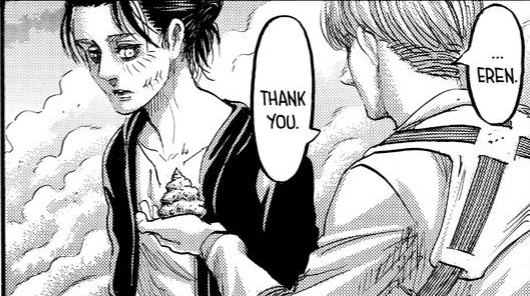
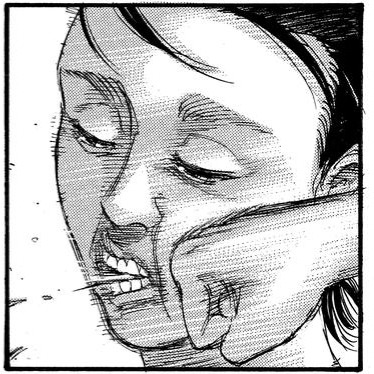
Is this the High School AU style?
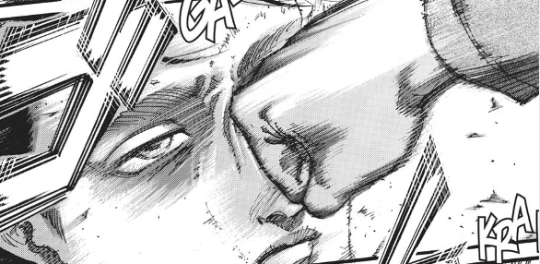
Compared to Chapter 112...You can tell the difference.
The way how the fandom views Chapter 139 is certainly very divided, but even amongst those who like it, most still think “things could have done better” (source: SNK Chapter 139 Poll), showing how awkward the style is compared to previous chapters. The inconsistencies in character portrayal and plot are too hard to ignore. It pains me to see a well-constructed and reputable series, one step away from legend even just with an average ending, closed with a chapter that almost defeats the purpose of the rest. Trust in Isayama – while he can build a legend in 10 years, he can also take it down with 1 chapter.
By the way, Levi is one of the few characters who isn’t ruined. Probably also a conscious choice.
#snk 139#aot 139#aot spoilers#aot analysis#attack on titan#isayama#shingeki no kyojin#eren#snk spoilers#hajime isayama#snk analysis
32 notes
·
View notes
Note
could you elaborate on the long term plot of greater boston? i don't mind spoilers! i tried it but couldn't get past the first episode :( but i trust your taste and i've liked every other show you've rec'd so i wanna keep listening
EDIT: okay for some reason the formatting of this post is EXTREMELY befuckened and I can’t get it to behave, so it’s possible that this isn’t going to display with a spoiler cut and if so I am VERY sorry. the “keep reading” break is in the ask instead of the body of the post I have no idea what’s happening right now but if you don’t want spoilers please be aware this post spoils like everything about the show
Sure thing! I will .... do my best, but because of the nature of GB’s plot it’s a bit difficult to describe it without ending up either way too detailed or way too vague. But I will absolutely do my best because if there is any show out there that deserves it, this is that show. Cut for Obvious Spoiler Reasons!
So, there’s a LOT of plot that goes on, but what a plot summary could never convey is that the real heart and soul of this show is the characters. There are a metric fuckton of them, and every one of them is multidimensional and dynamic and wonderful, even if it’s not always obvious at first.
Leon Stamatis of course starts the show by abruptly dying of Existential Crisis/Panic Attack on a roller coaster, which sets everything else in motion. Of that big ensemble cast, at first the most important players are
Nica, Leon’s little sister who wants to be famous but doesn’t really have any concrete plans as to how
Dimitri, Leon’s little brother who is currently traveling in a submarine attempting to find Atlantis and keeps sending Leon letters, unaware that he’s dead
Louisa, Leon’s recent ex, a wedding photographer who later quits and becomes a crime scene photographer slash detective
Leon’s best friend/roommate Michael, who is unemployed and has just had a relapse after being sober for 12 years because he has no idea what to do without Leon
Gemma, a lesbian who absolutely hates her job as an editor at Third Sight, a company which publishes magazines relating to astrology/psychic stuff/divination/etc
Charlotte, Gemma’s pregnant wife, who has recently lost her job as an animation background artist and is feeling directionless
Professor Paul Montgomery Chelmsworth, aka the Mayor of the Red Line, a slightly eccentric college professor and casual friend of Leon’s who is inspired by his death to call for a referendum declaring that the Red Line of the Boston subway system will become an independent city.
It’s that last one that is the real ~main plot~ of the show: at first, more and more of the characters getting caught up in the campaign to create the city of Red Line, and then the chaos that results when they succeed and actually have to run it. But you also have characters like Louisa and Nica and Michael, dealing with a whole rainbow of grief and distress as they cope with Leon’s death. His eccentric personality is the other driving force of the show’s events -- Leon was caring and compassionate, but also obsessed with timetables, organization, and scheduling every action in his life down to the minute.
The other major force in the show is Third Sight, a magazine publisher with a focus on fortunetelling and the like; Michael ends up working there, along with Gemma and several other major characters. Third Sight also has an enigmatic boss no one has ever seen, who turns out to be a manipulative little bastard named Oliver West.
While Red Line successfully becomes a city, “Mayor” Chelmsworth turns out to have some major commitment issues and vanishes as soon as the vote passes, leaving Charlotte and Gemma to clean up the mess. Charlotte ends up interim mayor, but also begins to campaign for the upcoming mayoral election, in which she has two opponents: Isabelle Powell, a Black realtor and an incredible character whom I absolutely cannot do justice here, and Emily Bespin, Literally The Worst Person Who Has Ever Existed, Holy Fuck I Hate Her So Much.
The election is being manipulated behind the scenes by Oliver West, who also takes advantage of Nica’s isolation and a near mental breakdown to convince her to help him by orchestrating several escalating ~pranks~ in Red Line. Honestly he’s manipulating literally everyone, and also heavily backing Emily Bespin, in an attempt to profit off of influence in the new city. Eventually this ends up with Michael kidnapped and imprisoned, several other characters attacked and one badly hurt during a wedding in Red Line, and Isabelle Powell’s nephew framed for the attack. That results in Powell’s supporters beginning a set of protests which throw Red Line into even further chaos, even as Charlotte and Nica begin to have some real moral epiphanies about how they’ve been acting.
As events continue to escalate and the election draws closer and closer, the now-assembled cast have to figure out just who exactly is manipulating events and how -- not to mention how to prove Powell’s nephew’s innocence, what the hell has happened to Michael, and what the hell they’re going to do if Bespin wins the election and makes good on her promise to evict everyone involved in the protests.
Meanwhile, Dimitri is traumatized by finding a mass grave at the bottom of the Pacific Ocean, gets rescued and then imprisoned in Alaska by infamous vanished plane hijacker DB Cooper, finally makes it home to Boston disillusioned and lonely only to inevitably find out his brother has been dead for two years, and then gets totally rejected by his sister, because he basically can’t catch a break.
Also meanwhile, the same conflicts playing out in Red Line play out on a more metaphysical level, in the structure of the show itself. While the first season only hints at the possibility that Leon might not be quite as gone as everyone thinks, as the show progresses Leon’s ghost makes his presence known by starting to argue with the omniscient narration. Increasingly taking over the show’s narration until a brilliant scene where said narrator quits and audibly gets up from the microphone and leaves, Leon, the man who spent his whole life trying to impose order on the chaos of the universe around him, finds himself battling the very structure of the story they’re in, in an attempt to help his friends as both he and they are caught up in the chaos of Red Line and Oliver West’s plans. Unfortunately, the structure of the story has other ideas, and plans of its own.
None of this, of course, even begins to touch on the cheese robots; or Michael’s ongoing struggle with self-actualization and alcoholism; or Mallory the foulmouthed teenager who somehow manages to first witness and then be involved in nearly every major plot event of the show; or the in-depth examination of structural racism as it relates to things like housing and city planning and Boston’s history and well-intentioned white liberals and the imprisonment of Black youth; or Star Trek obsessed chaotic neutral gay reporter Chuck Octagon and that one time he flirted with his own mirror universe self; or the complex but beautiful process of Charlotte and Gemma working on their relationship in the midst of all this chaos because while they have troubles throughout they truly love one another and are trying to be better people; or the fact that one of the other major characters is an insufferable Loud Vegan member of a polyamorous commune who -- on the advice of his ~spirit advisor~ the ghost of 19th century feminist writer Mary Wollstonecraft keeps changing his name throughout the show to things including Earthman, Panda Bear, Extinction Event, and Dipshit; or the unfortunately real Olive Garden food truck; or the laughter and the tears and the flamethrowers and the fact that one of the show’s most important and heartbreaking conversations takes place on an amusement park log flume ride audibly filled with liquid nacho cheese.
It’s a good show, is what I’m saying, basically.
#the podcast that never returned#more like THE SUMMARY THAT NEVER ENDED#I have no idea whether this is useful my apologies#Anonymous#asks#my posts
19 notes
·
View notes
Note
Hi, I'm just another major fan of your work (which is seriously beautiful by the way), and I'm just wondering about your thoughts on the recent bsd theory, which is that Chuuya would die during a battle against Fyodor. Whether you think it's true and how you personally feel about that? Thank you very much, and before I end this ask, I want to thank you for writing a Fyodor blog, Tumblr really needed it. I wish that you may have a wonderful day!
Hello! I’m so happy that you enjoy my stuff! I honestly wish I could express my gratitude for everyone who sends me nice messages in a better way, but sadly I’m not sure how. Thank you for sending me this too! I saw the post about this theory a couple days ago and I love writing about this kind of stuff.
Okay first off, to anyone who isn’t familiar with the theory, here’s the post. You might want to open it up for reference.
Since I love being overly detailed I’m going to present two contrasting arguments. Then I’m going to write a personal statement on what I think might happen, just to make this a little more organized.
Argument AGAINST the Foreshadowing of Chuuya’s Death:
The OP points out that Chuuya is the only puppet who is upside down. They then relate this to the fact that Fukuzawa and Mori are upside down as well and have already been brought to near death by Fyodor.
This may be a stylistic choice however. Notice how all the other puppets are positioned in different ways as well. None of the puppets are hanging in the same way. For instance, Yosano is hanging from one leg and the nape of her neck, Ranpo is hanging by one arm, Atsushi is hanging by his back, etc.
It should be noted that all of the puppets are hanging in different positions despite possibly having strings located in the same area. It would stand out much more if all of the puppets were in the same position except for Chuuya.
My personal belief is that Chuuya is upside-down because he can manipulate gravity and actually hang like that. Especially since his arms aren’t hanging limply like the other puppet’s bodies are. If he was simply hung upside down on purpose his arms should be falling past his head, his hands facing the ground. This seems to indicate to me that he’s meant to be using gravity manipulation.
His strings also seem to be attached to either his back or his neck, not his feet. If the strings are attached to his back/neck, he wouldn’t be able to hang like that naturally without gravity manipulation.
Therefore, I believe that this may have been a stylistic choice because of Chuuya’s ability. Sometimes people do things for no apparent reason too, and since we’re not aware how much the story has been planned out or how much Harukawa-Sensei knows about the story thus far, it’s hard to say if there is foreshadowing behind it.
Honestly, I haven’t noticed any very detailed foreshadowing in the series so far. If this was a series more known for that, I’d be more likely to believe that this was a hint that Chuuya might be killed. However, if you’ve noticed any small foreshadowing to an event that’s already occurred, let me know. I just might not be observant enough.
If I had more information about the process that Asagiri-Sensei and Harukawa-Sensei go through to release a chapter, I might have been able to infer more as to if this is foreshadowing or not. For instance, if the artist decides what to do with the spread, if the author tells the artist what to draw, or if collaboration occurs. Something like that would give me a better idea of it.
One final point; Chuuya is a fan favourite. I’m sure you’ve seen the copious amounts of Chuuya and Soukoku merch. Not to say that Asagiri-Sensei won’t kill off Chuuya because of this, but he might be advised against it by his editor/publisher. Especially since some fans will be terribly heartbroken and might stop reading the series if their favourite is gone. It’s Asagiri-Sensei’s decision in the end though.
Argument FOR the Foreshadowing of Chuuya’s Death:
It’s a damn good strategy to get Chuuya to use corruption without Dazai around.
First of all, Fyodor knows about his ability. The whole point of Fyodor getting that list was to strategize and attack based on the weaknesses of the mafia’s strongest members.
I’d like to bring up as a side note that it’s quite possible that Dazai’s ability was on the list too. We don’t know when A began compiling the list, so Dazai could’ve still been in the mafia at the time. Furthermore, if A used the mafia’s personal files to get this information, it’s likely that a detailed profile of Dazai’s ability still existed in the building after he left.
What I disagree on is the theory that Fyodor will fight Chuuya himself. Fyodor seems fairly cautious, and at this rate I feel like he’d rather have the ADA force Chuuya to use corruption.
Why?
1. Fyodor is out of harms way. If he dies so does his plan in the most likely case.
2. It’ll cause more deaths in both organizations. Consider the fact that corruption is uncontrollable without nullification. Chuuya has little consciousness during it, meaning he might just eliminate whatever’s in his path. Including both the ADA and mafia members.
3. In the end even if Chuuya kills no one, Chuuya still dies himself. Eliminating one of Fyodor’s (probably) largest threats.
Fyodor might fight Chuuya himself if he really wants Chuuya out of the way and the mafia vs. ADA fight doesn’t kill him.
The entire ADA and mafia fighting will be pretty intense though if they do decide to go all out. So I’m sure it might push Chuuya into a tight enough spot to employ corruption.
In my opinion Yosano is also at risk. She’s a healer after all, if either the mafia/Fyodor can kill her in a battle the ADA members won’t be able to recover from serious injuries quickly or possibly even at all.
My Personal Opinion:
The art was a stylistic choice. However, I can see Fyodor forcing Chuuya to use corruption, as this would benefit his plan greatly. Without Dazai nearby, corruption would defeat at least one major threat: Chuuya.
I like Chuuya, just like I like many of the other characters in the series. I’ll be honest though, I won’t be too heartbroken about most of the characters if they die. I don’t necessarily want him to die or anything, but whatever Asagiri-Sensei decides to do to is fine with me.
PS. I hope you have a wonderful day as well!
#bsd#bungou stray dogs#bsd theory#bungou stray dogs theory#bsd predictions#abstract-violence#theories#im taking a study break today since im tired as hell#this was fun to write though
62 notes
·
View notes
Text
How the LinkedIn Algorithm Works (And How to Make it Work for You)
When you log in at LinkedIn.com or use the LinkedIn app, you’re immediately taken to your homepage feed. This page acts very much like the Facebook feed, where you see updates from your friends or Pages you follow.
You’ll notice, however, that your LinkedIn feed doesn’t show everything your network is posting by default. That’s because it’s only showing content it believes is relevant to you.
Note: users can switch the posts they want to see based on “recent” activity (but this has to be done manually).
So, how can you, as a social media marketer, ensure your content appears in as many feeds as possible?
Bonus: Download a free guide to discover four time-saving tools to help you grow your LinkedIn network faster. Includes one tool that lets you schedule a week’s worth of LinkedIn updates in just three minutes.
How the LinkedIn algorithm works
LinkedIn’s algorithm is designed to make homepage feeds more enticing and user-friendly. The social network has published a lot of articles on the updates and improvements they continue to make to the algorithm, including:
Strategies for Keeping the LinkedIn Feed Relevant
LinkedIn’s Feed Made Faster and Smarter
Making Your Feed More Relevant – Part I
Making Your Feed More Relevant – Part 2: Relevance models and features
Feed Personalization Articles
Feed
Distribution of Your Articles – LinkedIn’s Publishing Platform (applicable to writers posting on LinkedIn’s blogging tool)
Note: there are other LinkedIn algorithms that may affect things like search, or spam messages in your inbox. But those are not what we’re talking about here. We are specifically focusing on the algorithm that organizes the homepage feed.
To begin with, your LinkedIn feed has a spam filter, which determines:
Whether your content shows up in the feed (it’s rare it will be taken down, though)
How far of an audience it reaches within LinkedIn (the most important part)
Whether to take you down as a spam user (also rare)
Below is a diagram showing how the LinkedIn algorithm works on the feed, and the four stages of the content review process:
Keep in mind these stages are not completely sequential or divided. Multiple factors affect how far a post spreads throughout the network, and these algorithmic decisions happen over time, sometimes moving the post backwards and forwards in the process.
Stage 1: Content is posted and passes an initial, computerized filter
Every time you post an update to LinkedIn (even if it’s an image), a bot immediately places the content into one of three categories:
“Spam”’
“Low-quality”
“Clear”
You want to be in the “clear” category. But if for some reason your content gets placed the “low-quality” category, you may still have hope, and could still move on to the next stages.
Stage 2: Content is left on the feed temporarily to measure engagement
At this stage, indicators of initial engagement from your audience (such as likes, comments and shares) will signal that your content is good enough to pass to stage 3 of the algorithm’s spam filter.
However, if users flag your post as spam, or hide it from their feeds because they don’t want to see it, LinkedIn’s algorithm will draw more negative conclusions.
To avoid having users “hide” your content from their feeds, consider the following:
Is my post annoying or offensive?
Am I over-posting?
Would people in my network care about this post?
Is my post so unique and insightful, people would want to share with others?
Is my post relevant to others’ professional lives?
When determining your answers to the above, you may want to re-think your post, or tone it down a bit. We’ll give more tips on hacking the LinkedIn algorithm below.
Stage 3: Content passes a computerized “virality” check
After users engage with your content to signal its quality score, the algorithm looks for clues as to the quality of the poster and the poster’s network to determine if the content is spam or not.
This is because a spammer could technically have posted garbage and gotten hundreds of other spam accounts to like and comment on the post within an hour, still successfully making it to stage 3.
Besides checking your credibility, the algorithm may also be determining the relevance and usefulness of the post to the network (i.e., the connections and followers receiving the post in their feeds) at stage 3.
As such, this stage is also when the algorithm decides whether to “demote” your content, sending it backwards in the queue for another chance at winning credibility. If your post looks “suspicious,” but the algorithm doesn’t want to make a definitive call on it (giving you the benefit of the doubt), it will remain in the feed but not show very highly or very frequently. At this point, it’s up to your audience to give your content the engagement metrics mentioned in stage 2. If it gets more engagement, it moves back to stage 3.
PRO TIP: This is why posting at the right time, plus optimizing your headlines and images for click-through-rate (CTR) are important. See below for more on this.
Stage 4: Content is reviewed by human editors
Part of the LinkedIn algorithm’s uniqueness is that it uses real humans to filter through user-generated content, and to learn more about what makes a post noteworthy (or not).
This is the stage where those humans determine whether your post is valuable enough to continue displaying in the LinkedIn feed. If your post continues to get engagement, the cycle continues, and it keeps getting shown.
There’s a lot of speculation that, at this stage, if your content is amazing, it may get a boost and reach more people. It might even show up on a LinkedIn Channel (see below for more on this).
Take a look at the sample post below. At the time of the screenshot, it was two weeks old. But, it had plenty of likes and comments (i.e., LinkedIn engagement signals). It was also liked by someone in my own network, and was relevant to content in my personal profile (such as marketing). You can’t see it in the screenshot below, but this post was ranked above another that was up for less than a day!
As a result, the post kept showing up in my newsfeed, exemplifying the recirculation power of the LinkedIn algorithm:
Note: Pulse is now integrated into your homepage feed. But Pulse articles from the LinkedIn Publisher tool work a little differently when being shown to your audience, or on Pulse Channels.
8+ tips on how to “beat” the LinkedIn algorithm
Now the fun part: learning how to make the algorithm work in your favor (a.k.a. getting your posts seen by as many people as possible).
1. Understand the type of content that LinkedIn craves
LinkedIn sources are fairly clear on what they want the focus of their platform to be: the professional world.
Instead of animated GIFs, Ellen videos and “texts-from-my-mom” screenshots, the LinkedIn algorithm aims to show users news, job posts and timely, popular content related to your career (or those of peers you’re connected to). This kind of content can be images, videos, LinkedIn article posts, external webpage links or text updates.
Any content you post should:
Be of value to someone’s career (whether as a business owner or employee)
Offer a tip related to business growth, or a career
Inspire someone in their work life
Be relevant to the industry in which you operate in
Come from a credible source
For examples, take a look at the types of content LinkedIn promises to deliver in its Pulse app.
Also, remember that part of the LinkedIn algorithm is designed to find a factor of relevance to the audience a post is being shared with.
How does LinkedIn determine relevance? By looking at people’s profiles. And user profiles are all about their careers and businesses.
Take a look below at some of the posts that LinkedIn thought I’d be interested to see on my homepage feed.
An inspirational leadership quote (22 likes in 15 hours):
An article from the BBC (a credible source), trending in an industry I work in (1,078 likes and 18 comments):
A blog post written on LinkedIn by one of my connections. It only had 1 like in 7 hours, but notice the hashtag usage. Can you guess what stage in the algorithm this post was likely in, at the time of the screenshot? Hint: it’s possible it was stage 1 or 2!
An article by a LinkedIn Influencer that someone in my network had commented on. It had 60,715 likes and 1,846 comments in seven days (LinkedIn influencers pre-pass stage four in the LinkedIn algorithm, but other posts that get this far would surely have passed the human editor check).
You get the idea.
2. Build your audience (personal or business) strategically
We know that relevance, credibility, followers and connections play a big part in the LinkedIn algorithm. So, it goes without saying you should be growing your personal or business audience (or both) on LinkedIn.
Whether you run a personal profile or a Company Page on LinkedIn, be sure to:
Fill out your personal profile and Company Page as completely as you can, and keep them updated.
Add connections (people you know, or think would be interesting to see updates from).
Encourage employees to indicate they work at your company.
Follow others and attract followers (these are different than connections on LinkedIn).
Participate in LinkedIn Groups, or host your own.
Give and receive recommendations.
Make sure your profile is public, so more people can find you, add you and see your posts (especially Publisher or Pulse posts, explained below).
Join conversations and be active on the network, generally.
Promote your LinkedIn profiles and Company pages on your website and in other appropriate spaces (e.g., employee bios, business cards and brochures, email newsletters, email signatures, etc.). Setting up customized URLs is useful for this.
Here are some resources to help you get started on the above:
LinkedIn for Business: The Ultimate Marketing Guide
How to Be Found on LinkedIn
LinkedIn Profile Tips: 9 Ways to Keep Your Page Fresh
3. Strive to be an Influencer
LinkedIn’s Official Blog made a clear statement in 2016 that feeds would intentionally contain Influencer content.
Influencers are credible users (usually company leaders) writing content approved by LinkedIn editors. They automatically pass the “no spam” test as a result.
LinkedIn Influencer content shows up on the LinkedIn feed with a special icon next to the poster’s name. It’s akin to a verification badge on a platform like Twitter.
So, how do you become a LinkedIn Influencer?
It used to be that you could apply to be one. Nowadays, it’s a select club of invite-only users.
But that doesn’t mean you should give up hope.
LinkedIn gives advice on how to get yourself to the top echelons of LinkedIn content creators. Follow their lead (and our tips in this article), to start producing amazing content they’ll notice.
4. Optimize your content for engagement
Content you post on LinkedIn should be optimized for engagement and quality. Below are LinkedIn’s actionable tips for producing the best content for its network.
Include puns or fun jokes to make professionals laugh—usually at their industry.
Provide useful, career-related tips.
Show impressive industry or company stats.
Keep it short and include a link, image, or video.
Evoke an emotion.
Next, check out these tips on our blog:
The Professional Boost: How to Go Viral on LinkedIn
Best Practices for Sharing Content on LinkedIn Company Pages
How do know if your content is performing well, even when using the tips above? Look to the data:
A/B Testing on Social Media: How to Do it with Tools You Already Have
LinkedIn Analytics: A Guide for Marketers
Remember, when you do get those hard numbers, it’s important to learn something from them. Keep revising and experimenting until you figure out what works best for your audience (and in your industry) on LinkedIn.
5. Post to the LinkedIn feed at the right time
If you’re posting at 2 a.m., when most of your network is asleep (time-zone nuances aside), your post can be up for hours before receiving likes or comments, no matter how good it is.
This is why posting to the LinkedIn feed at the right time is important.
But when is that time? A popular hypothesis is “working hours,” because LinkedIn is a professional network, and most people work 9 a.m. – 5 p.m.
However, some suggest that posting when workaholics are likely to take a break and visit LinkedIn is better.
The LinkedIn Sales and Marketing Solutions EMEA Blog says the best time to post is 8 p.m., but that you need to find your own “8 p.m. moment.” That’s when decision-making is supposedly done, even if it’s at home.
According to yet another LinkedIn article, the best time to post is going to depend on tests you perform. This is because location, time zones and people’s daily habits affect when they’re on LinkedIn—and that differs in any given audience segment.
In fact, 50% of LinkedIn users check their accounts through mobile devices, implying you have as much of a chance of reaching people after hours as you do during the workday.
6. Share other users’ posts, and they’ll probably share yours
Remember that LinkedIn is primarily a social network, so it helps to be social!
Be kind to others by sharing their posts, or embedding their videos on your site. You’d be surprised at how many will like your share, comment to say thanks, or reshare your posts to give you credit on their network. These actions increase your profile reach.
Plus, if you’re striving to be a LinkedIn Influencer, making friends on LinkedIn is a good idea.
6. Share other users’ posts, and they’ll probably share yours
Remember that LinkedIn is primarily a social network, so it helps to be social!
Be kind to others by sharing their posts, or embedding their videos on your site. You’d be surprised at how many will like your share, comment to say thanks, or reshare your posts to give you credit on their network. These actions increase your profile reach.
Plus, if you’re striving to be a LinkedIn Influencer, making friends on LinkedIn is a good idea.
7. Use the LinkedIn Publisher tool
There’s no doubt that LinkedIn is pushing posts that originate from their Publisher tool (which end up on LinkedIn Pulse, now integrated with the homepage feed).
The Publisher tool on LinkedIn is like a blogging platform—it’s made for users to publish as individual authors (not hiding behind a company name). You or your employees can write blog posts through Publisher and share them to your network(s).
The Publisher tool on LinkedIn is like a blogging platform—it’s made for users to publish as individual authors (not hiding behind a company name). You or your employees can write blog posts through Publisher and share them to your network(s).
LinkedIn’s Corporate Publishing Playbook recommends you use your employees’ expertise as your brand “assets” in this regard (see slide 6 on this Slideshare presentation).
The Editor-in-Chief at LinkedIn explains that Publisher posts show up in the feed for your connections and followers based on time. So, be sure to follow our engagement tips above, to keep the post circling through the LinkedIn algorithm.
However, Publisher posts get even more exposure outside the homepage feed on LinkedIn. They are shown on:
Your profile
Highlights emails to your connections and followers (if they are signed up for them)
Notifications (sometimes, if they’re relevant), including on the LinkedIn Pulse app (now integrated with the feed)
Channels
Note: Channels are curated categories of Publisher posts found within LinkedIn Pulse. If your content is good, it could be placed in these featured areas for more eyes to see.
8. Promote your LinkedIn Publisher articles
Below are some tips to get your LinkedIn articles in front of people, benefiting your rank in the LinkedIn algorithm.
@mention other LinkedIn members
When you write a Publisher post, be sure to actively share it, and use the @mention feature to tag relevant LinkedIn members. This will notify other users, and their networks, when your content is applicable to them (you don’t need to be officially connected to do this).
For example, you can @mention someone you quoted in your article, or whom you linked to. They’ll likely be flattered may even reshare it to their audience.
Or, you can @mention personal connections you feel would benefit from the article (but never spam a bunch of random users for exposure!).
Use hashtags
Hashtags will make your post discoverable by other users who are looking for information on that topic (when using LinkedIn’s search bar). They might then share it with their networks, increasing your exposure.
Use common SEO and content marketing tactics
Search engines, at one point or another, need to rely on factors like keywords to determine what a URL is about. And, good internet marketers know the value of a strong headline and image.
With that in mind, freshen up your SEO and content marketing skills before posting to LinkedIn. Here are some resources to get you started:
How to Write for SEO Without Sounding Like You’re Writing for SEO and Why You Should (an article I wrote on how it’s important to understand the value of keywords without overstuffing or sounding unnatural)
You’ll Never Believe the Strange Science of Click Bait
7 Key Strategies to Write Clickable Content for Every Social Network
10 Quick Social Media Ad Writing Tips From an Expert (still applicable even if you’re not writing ads)
Ask for a follow
This may sound somewhat forward, but hear me out. Since people can now follow, and not just connect with you on LinkedIn, there’s no harm in asking for the follow when you publish a striking article.
When you share your post, try adding a short sentence—with a clear benefit—like, “follow me for more on this topic next week!”
The more followers you have, the more people are likely to see your future posts in their homepage feed. Your content will have more potential to get those engagement signals we now know are so crucial to the LinkedIn algorithm.
Share on outside social media
Use the tools LinkedIn gives you to share on Twitter. Plus, use a platform like Hootsuite to syndicate your article to multiple social media profiles, giving it an extra traffic boost.
Share to LinkedIn Groups
If you’re part of LinkedIn Groups (and you should be), use the opportunity to post your Publisher articles to those groups when it contains useful content for group members. The benefit here is that you’ll show the article to group members who may not be your 1st degree connections or followers. If it’s useful, they’ll hopefully share it to their networks or become a follower.
For example, you can use your articles to answer someone’s question, or use group member questions to inspire your content. You can also start a post on the group page, inducing a conversation about your enticing, topical and relevant article.
Try sponsored content
While you could use paid advertisements to help share your LinkedIn Publisher posts, you may get better conversions by leading ad-clicks to your website blogs, with specialized calls-to-action (CTAs). See our section below on repurposing your website content on LinkedIn.
Plus, follow our guide to LinkedIn Ads for more on this topic:
A Guide to LinkedIn Ads: How to Run a Successful Campaign
Keep in mind that the guidelines for sharing any LinkedIn content still apply to sponsored posts. See this ad from SharpSpring, and notice it stays within the realm of being useful, professional, and targeted for a LinkedIn audience:
Users can treat ads like any other piece of content, to further personalize their feed:
Paying to promote spammy or irrelevant content won’t help you. Always keep your audience in mind when sharing content on LinkedIn.
The LinkedIn Marketing Solutions blog published a post that emphasizes the importance of audience targeting when setting up ad campaigns on its network.
Allow comments on your articles, and reply to them
While you may fear spam and negative trolling, keep in mind comments are an engagement signal for the LinkedIn algorithm. That makes them necessary to keep your content in the LinkedIn feed.
Keep your audience engaged and let them know you’re listening. When appropriate, respond to comments to keep those engagement signals going.
Use LinkedIn analytics
Like we mentioned above, always use data and analytics to continually improve your content and its reach. Test the headline, photo, teaser text, share text, and even the time you shared a post. LinkedIn provides analytics to its users for this purpose.
Hootsuite also offers a tool to help you gauge the effectiveness of your team’s social media efforts.
Repurpose content from your website’s blog, within reason
We know what you’re thinking when repurposing content: what about SEO? That’s a very good question. Traditionally, SEOs will say you should avoid duplicate content on your website, which can cause ranking dilutions in the search engines.
However, you can be safe from duplicate content issues when posting through LinkedIn Publisher in two ways:
A reliance on search engines to understand the original source of content, and the intended reuse on other domains.
A nifty HTML linking trick SEOs use, called the Canonical rel link.
This process is explained more fully, with examples, in the following article I’ve written to answer this question:
Should you re-publish your blog articles on high quality websites?
So rest easy. You don’t need to create separate posts for your website and your LinkedIn profile. You can tactfully repurpose the same posts, but only if they’re worth the effort.
Don’t overuse this strategy though—you still want to attract people to your website for original content!
Key takeaways
What have we learned about how the LinkedIn algorithm works?
Engagement is critical to the LinkedIn algorithm.
Engagement is dependent on relevancy, the reach of your network, the times they are checking LinkedIn and your credibility within that audience.
Using the LinkedIn Publisher platform is a good idea. Sometimes, you can republish posts from your blog, but not always, and only when you know what you’re doing.
Reciprocity wins on any social media, including LinkedIn.
Use analytics and experiments to refine your LinkedIn posting strategy, further improving your algorithm hacks.
With that said, start experimenting with posts on LinkedIn, and start spending time on the LinkedIn feed, to get acquainted with the audience you’ll be interacting with. Get to know their likes and habits, and be known as a producer of engaging content yourself!
Schedule posts and manage your brand’s LinkedIn presence with Hootsuite. Try it free today.
Get Started
The post How the LinkedIn Algorithm Works (And How to Make it Work for You) appeared first on Hootsuite Social Media Management.
How the LinkedIn Algorithm Works (And How to Make it Work for You) published first on https://themarketingheaven.tumblr.com/
0 notes